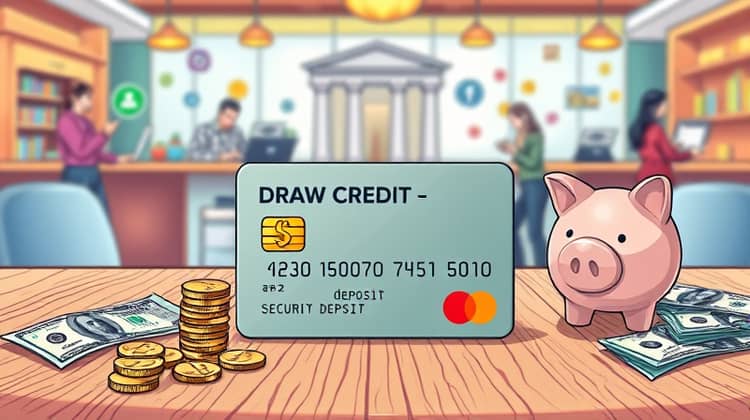The world of credit cards can be daunting, particularly when trying to understand the differences between secured and unsecured credit cards. Whether you're a first-time user or looking to rebuild your credit, it's essential to know which type of credit card is best for your financial situation.
This article will explore the features, pros, and cons of secured and unsecured credit cards, helping you make a well-informed choice about your options. We will also highlight key differences and share tips on selecting the best card type for your needs.
Secured Credit Cards

Secured credit cards are a popular option for individuals who are looking to build or rebuild their credit scores. They work by requiring a security deposit, which acts as collateral in case the cardholder fails to make payments. This deposit usually sets the credit limit on the card, meaning that if you deposit $500, you have a $500 credit limit.
These cards are often issued to individuals with no credit history or those with poor credit scores. Because the deposit mitigates the risk for lenders, secured credit cards can be easier to get approved for compared to unsecured options.
- Require a cash deposit that serves as collateral
- Help build or rebuild credit history
- Often have higher interest rates than unsecured cards
- May come with additional fees like annual fees
- Credit limit typically equals the deposit amount
Secured credit cards can be a stepping stone to better credit options and are ideal for individuals who are serious about improving their financial standing.
Unsecured Credit Cards

Unsecured credit cards do not require a cash deposit, making them more accessible for individuals with existing credit histories. These cards offer a credit limit without the need for collateral, allowing cardholders greater flexibility. However, they typically require a good to excellent credit score for approval.
Unsecured credit cards often come with perks and rewards programs, making them appealing for users who want to earn points or cashback on their purchases. While they may impose fees or elevated interest rates as well, there is often more variety in the offerings available in this category.
- No cash deposit required
- Credit limit is not secured by collateral
- More varied rewards programs available
- Potentially lower interest rates than secured cards
- Higher likelihood of incurring fees such as late payment charges
For those with a solid credit history, unsecured credit cards can provide beneficial rewards and incentives that can enhance the cardholder's experience.
Key Differences Between Secured and Unsecured Credit Cards

Understanding the primary differences between secured and unsecured credit cards is crucial for making an informed decision. Secured cards require a deposit, while unsecured cards do not, which means their terms and usage can vary significantly.
Another key difference lies in the overall credit risk: secured credit cards are designed to be low-risk for lenders, making them accessible to those with less favorable credit scores, while unsecured cards often cater to consumers with established credit profiles.
- Secured cards require collateral in the form of a cash deposit.
- Unsecured cards offer credit without requiring any security deposit.
- Secured cards are easier to obtain with lower credit scores.
- Unsecured cards often provide better rewards and benefits for users.
- Secured cards generally have higher interest rates and fewer features.
Becoming aware of these differences can aid in your decision-making process, ensuring that you select a card that fits your financial needs and goals.
Pros and Cons

Every financial product has its advantages and disadvantages, and credit cards are no exception. Secured credit cards are beneficial for those looking to build or rebuild credit, as they provide a way to demonstrate responsible credit usage. However, they also require upfront cash and may come with higher fees.
Conversely, unsecured credit cards provide more flexibility and are often more attractive due to their rewards systems. Yet, they might pose risks for individuals with lower credit scores, as the potential for high-interest rates can lead to debt accumulation if not managed properly.
- Secured cards help establish or rebuild credit history.
- Unsecured cards offer greater purchasing power and flexibility.
- Secured cards come with fewer rewards but lower risks for lenders.
- Unsecured cards can provide valuable rewards for regular users.
- Secured cards may require upfront cash, making them less accessible for some.
Considering the pros and cons of each card type is essential for aligning your choice with your financial aspirations and lifestyle.
How to Choose Between Secured and Unsecured Credit Cards

When deciding between secured and unsecured credit cards, it's important to evaluate your current credit situation and your financial goals. Start by assessing your credit score; if it's low, a secured card may serve as a valuable tool for improvement. On the other hand, if you have a decent score, an unsecured card may offer more immediate benefits and rewards.
Next, consider your spending habits and needs. If you're someone who frequently makes purchases and can pay off the balance each month, an unsecured card with rewards may be attractive. Conversely, if you're looking for a path to rebuild your credit while keeping spending minimal, a secured card may be the way to go.
- Check your credit score to determine your eligibility for unsecured cards.
- Evaluate your spending habits to see if rewards programs are beneficial.
- Identify whether you can manage your credit responsibly to avoid debt.
- Consider your financial goals: are you looking to build credit or maximize reward opportunities?
In conclusion, selecting between secured and unsecured credit cards is a personal decision that depends on your unique financial situation and long-term objectives. By carefully weighing your options, you’ll be better positioned to choose a card that meets your needs and aligns with your financial path. Remember that financial responsibility plays a critical role, regardless of which card you choose!














